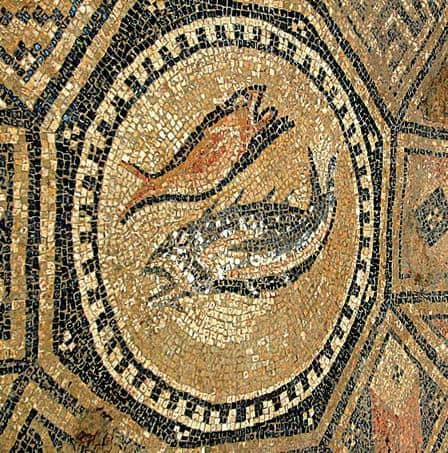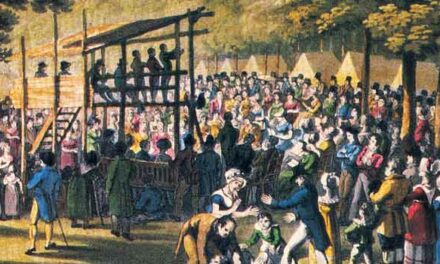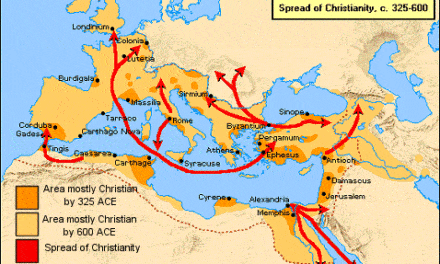This episode of Communio Santorum is titled, “And In the East – Part 2.”
In our last episode, we took a brief look at the Apostle Thomas’ mission to India. Then we considered the spread of the faith into Persia. Further study of the Church in the East has to return to the Council of Chalcedon in the 5th C where Bishop Nestorius was condemned as a heretic.
As we’ve seen, the debate about the deity of Christ central to the Council of Nicea in 325, declared Jesus was of the same substance as the Father. It took another hundred years before the deity-denying error of Arianism was finally quashed. But even among orthodox & catholic, Nicean-holding believers, the question was over how to understand the nature of Christ. He’s God – got it! But he’s also human. How are we to understand His dual-nature. It was at the Council of Chalcedon in 451 that issue was finally decided. And the Church of the East was deemed to hold a position that was unorthodox.
The debate was sophisticated & complex, and not a small part decided more by politics than by concern for theological purity. The loser in the debate was Bishops Nestorius, Patriarch of Constantinople. To make a complex issue simple, those who emphasized the unity of the 2 natures came to be called the Monophysites = meaning a single nature. They regarded Nestorius as a heretic because he emphasized the 2 natures as distinct; even to the point of saying Nestorius claimed Jesus was 2 PERSONS. That’s NOT what Nestorius said, but it’s what his opponents managed to get all but his closest supporters to believe he said. In fact, when the Council finally issued their creedal statement, Nestorius claimed they only articulated what he’d always taught. Even though the Council of Chalcedon declared Nestorianism heretical, the Church of the East continued to hold on to their view in the dual nature of Christ, in opposition to what they considered the aberrant view of monophysitism.
By the dawn of the 6th C, there were 3 main branches of the Christian church:
The Church of the West, which looked to Rome & Constantinople for leadership.
The Church of Africa, with its great center at Alexandria & an emerging center in Ethiopia;
And the Church of the East, with its center in Persia.
As we saw last episode, the Church of the East was launched from Edessa at the border between Northern Syria & Eastern Turkey. The theological school there transferred to Nisibis in Eastern Turkey in 471. It was led by the brilliant theologian Narsai. This school had a thousand students who went out from there to lead the churches of the East. Several missionary endeavors were also launched from Nisibis – just as Iona was a sending base for Celtic Christianity in the far northwest. The Eastern Church mounted successful missions among the nomadic people of the Middle East & Central Asia between the mid-5th thru 7th Cs. These included church-planting efforts among the Huns. Abraham of Kaskar who lived during the 6th C did much to plant monastic communities throughout the East.
During the first 1200 years, the Church of the East grew both geographically & numerically far more than in the West. The primary reason for this is because in the East, missionary work was largely a movement of the laity. As Europe moved into the Middle Ages with its strict feudal system, travel ground to a standstill, while in the East, trade & commerce grew. This resulted in the movement of increasing numbers of people who carried the Faith with them.
Another reason the Church in the East grew was persecution. As we saw last time, before Constantine, the persecutions of the Roman Empire pushed large numbers of believers East. Then, when the Sassanids began the Great Persecution of Christians in Persia, that pushed large numbers of the Faithful south & further East. Following the persecution that came under Shapur II, another far more severe round of persecution broke out in the mid-5th C that saw 10 bishops and 153,000 Christians massacred within a few days.
When we think of Arabia, many immediately think of Islam. But Christianity had taken root in the peninsula long before Muhammad came on the scene. In fact, a bishop from Qatar was present at the Council of Nicea in 325! The Arabian Queen Mawwiyya, whose forces defeated the Romans in 373, insisted on receiving an orthodox bishop before she would make peace. There was mission-outreach to the south-eastern region of Arabia, in what is today Yemen before the birth of Muhammad by both Nestorian & Monophysite missionaries. By the opening of the 6th C, there were dozens of churches all along the Arabian shore of the Persian Gulf.
The rise of Islam in the 7th C was to have far-reaching consequences for the Church in the East. The Persian capital at Ctesiphon fell to the Arabs in 637. Since the Church there had become a kind of Rome to the Church of the East, the impact was massive. Muslims were sometimes tolerant of religious minorities but only as communities of the disenfranchised known as dhimmi. They became ghettoes stripped of their vitality. At the same time, the Church of the East was being shredded by Muslim conquests, it was taking one of its biggest steps forward by reaching into China in the mid 7th C.
While the Church of the West grew mostly by the work of trained clergy & the missionary monks of Celtic Christianity, in the East, as often as not, it was Christian merchants & craftsmen who advanced the Faith. The Church of the East placed great emphasis on education and literacy. It was generally understood being a follower of Jesus meant an education that included reading, writing & theology. An educated laity meant an abundance of workers capable of spreading the faith – & spread it they did! Christians often found employment among less advanced people, serving in government offices, & as teachers & secretaries. They helped solve the problem of illiteracy by inventing simplified alphabets based on the Syriac language which framed their own literature & theology.
While that was at first a boon, in the end, it proved a hindrance. Those early missionaries failed to understand the principle of contextualization; that the Gospel is super-cultural; it transcends things like language & traditions. Those early missionaries who pressed rapidly into the East assumed that their Syrian-version of the Faith was the ONLY version & tried to convert those they met to that. As a consequence, while a few did accept the faith & learned Syrian-Aramaic, a few generations later, the old religions & languages reasserted themselves and Christianity was either swept away or so assimilated into the culture that it wasn’t really Biblical Christianity any longer.
The golden age of early missions in Central Asia was from the end of the 4th C to the latter part of the 9th. Then both Islam & Buddhism came onto the scene.
Northeast of Persia, the Church had an early & extensive spread around the Oxus River. By the early 4th C the cities of Merv, Herat & Samarkand had bishops.
Once the Faith was established in this region, it spread quickly further east into the basin of the Tarim River, then into the area north of the Tien Shan Mountains & Tibet. It spread along this path because that was the premier caravan route. With so many Christians engaged in trade, it was natural the Gospel was soon planted in the caravan centers.
In the 11th C the Faith began to spread among the nomadic peoples of the central Asian regions. These Christians were mostly from the Tartars & Mongol tribes of Keraits, Onguts, Uyghurs, Naimans, and Merkits.
It’s not clear exactly when Christianity reached Tibet, but it most likely arrived there by the 6th C. The territory of the ancient Tibetans stretched farther west & north than the present-day nation, & they had extensive contact with the nomadic tribes of Central Asia. A vibrant church existed in Tibet by the 8th C. The patriarch of the Assyrian Church in Mesopotamia, Timothy I, wrote from Baghdad in 782 that the Christian community in Tibet was one of the largest groups under his oversight. He appointed a Tibetan patriarch to oversee the many churches there. The center of the Tibetan church was located at Lhasa and the Church thrived there until the late 13th C when Buddhism swept through the region.
An inscription carved into a large boulder at the entrance to the pass at Tangtse, once part of Tibet but now in India, has 3 crosses with some writing indicating the presence of the Christian Faith. The pass was one of the main ancient trade routes between Lhasa and Bactria. The crosses are stylistically from the Church of the East, and one of the words appears to be “Jesus.” Another inscription reads, “In the year 210 came Nosfarn from Samarkand as an emissary to the Khan of Tibet.” That might not seem like a reference to Christianity until you take a closer look at the date. 210! That only makes sense in reference to measuring time since the birth of Christ, which was already a practice in the Church.
The aforementioned Timothy I became Patriarch of the Assyrian church about 780. His church was located in the ancient Mesopotamian city of Seleucia, the larger twin to the Persian capital of Ctesiphon. He was 52 & well past the average life expectancy for people of the time. Timothy lived into his 90’s, dying in 823. During his long life, he devoted himself to spiritual conquest as energetically as Alexander the Great had to the military kind. While Alexander built an earthly empire, Timothy sought to expand the Kingdom of God.
At every point, Timothy’s career smashes everything we think we know about the history of Christianity at that time. He alters ideas about the geographical spread of the Faith, its relationship with political power, its cultural influence, & its interaction with other religions. In terms of his prestige & the geographical extent of his authority, Timothy was the most significant Christian leader of his day; far more influential than the pope in Rome or the patriarch in Constantinople. A quarter of the world’s Christians looked to him as both a spiritual & political head.
No responsible historian of Christianity would leave out Europe. Omitting Asia from the record is just as unthinkable. We can’t understand Christian history without Asia or Asian history without Christianity. The Church of the East cared little for European developments. Timothy I knew about his European contemporary Charlemagne. The Frankish ruler exchanged diplomatic missions with the Muslim Caliphate, a development of which the leader of the Church in the East would have been apprised. Timothy also knew Rome had its own leader called the Pope. He was certainly aware of the tension between the Pope & the Patriarch of Constantinople over who was the de-facto leader of the Christian world. Timothy probably thought their squabble silly. Wasn’t it obvious that the Church of the East was heir to the primitive church? If Rome drew its authority from Peter, Mesopotamia looked to Christ himself. After all, Jesus was a descendant of that ancient Mesopotamian Abraham. And wasn’t Mesopotamia the original source of culture & civilization, not to mention the location of the Garden of Eden? It was the East, rather than the West, that first embraced the Gospel. The natural home of Christianity was in Mesopotamia & Points East. According to the geographical wisdom of the time, Seleucia stood at the center of the world’s routes of trade & communication, equally placed between the civilizations that looked respectively to the West & the East.
All over the lands of modern-day Iraq & Iran believers built huge & enduring churches. Because of its setting close to the Roman frontier, but far enough beyond to avoid interference—Mesopotamia retained a powerful Christian culture that lasted through the 13th C. Throughout the European Middle Ages the Mesopotamian church was as much a cultural & spiritual Christian headquarters as France or Germany or even that outstanding missionary base of Ireland.
Several Mesopotamian cities like Basra, Mosul, Kirkuk, & Tikrit were thriving centers of Christianity for centuries after the arrival of Islam. In 800 AD, these churches & the schools attached to them were repositories of the classical scholarship of the Greeks, Romans & Persians that Western Europe would not access for another 400 years!
Simply put, there was no “Dark Age” in the Church of the East. From Timothy I’s perspective, the culture & scholarship of the ancient world was never lost. More importantly, the Church of the East countenanced no break between the primitive church that rose in Jerusalem in the Book of Acts and themselves.
Consider this: We can easily contrast the Latin-speaking, feudal world of the European Middle Ages with the ancient Middle-Eastern church rooted in a Greek & Aramaic speaking culture. The Medieval Church of Europe saw itself as pretty far removed from the Early Church. Both in language & thought forms, they were culturally distinct & distant. But in Timothy I’s time, that is, the early 9th C, the Church of the East still spoke Greek & Aramaic. Its members shared the same basic Middle Eastern culture & would continue to do so for centuries. As late as the 13th, they still called themselves “Nazarenes,” a title the first Christians used. They called Jesus “Yeshua.” Clergy were given the title “rabban” meaning teacher or master, related to the Hebrew – “rabbi.”
Eastern theologians used the same literary style as the authors of the Jewish Talmud rather than the theological works of Western Europe. As Philip Jenkins says, if we ever wanted to speculate on what the early church might have looked like if it had developed while avoiding its alliance with Roman state power, we have but to look East.
Repeatedly, we find Patriarch Timothy I referring to the fact that the Churches of the East used texts that were lost to & forgotten in the West. Because of their close proximity to the setting of so much Jewish and early Christian history, Eastern scholars had abundant access to ancient scriptures & texts. One hint of what was available comes from one of Timothy’s letters.
Written in 800, Timothy answered the questions of a Jew in the process of converting to Christianity. This Jew told the Patriarch of the recent finding of a large hoard of ancient manuscripts, both biblical & apocryphal, in a cave near Jericho. The documents had been acquired by Jerusalem’s Jewish community. Without much doubt, this was an early find of what later came to be known as the Dead Sea Scrolls. Thank God, this early find didn’t move treasure hunters to ransack the other caves of the area! In any case, as now, scholars were thrilled at the discovery. Timothy responded with all the appropriate questions. He wanted to know what light the find might shed on some passages of Scripture he was curious about. He was eager to discover how the newfound texts compared with the known Hebrew versions of the OT. How did they compare with the Greek Septuagint? Timothy was delighted to hear back that the passages he was concerned about did indeed exist in the ancient manuscripts.
Timothy’s questions are impressive when we compare them to what Western Latin scholars would have made of such a find. They had no idea of the issues Timothy raised. They could not even have read the language of the ancient manuscripts. Only a handful of Western scholars would even have known how to hold the manuscripts: for instance—which way was up and how do you read them, from left to right or vice-versa?
The Church of the East Timothy I led was devoted to both scholarship & missionary activity. While the Latin Church saw the Atlantic Ocean as a wall blocking expansion to the West, the Church of the East saw Asia as a vast region waiting to be evangelized.
The Eastern Church was divided into regions known as Metropolitans. A Metropolitan was like an archbishop, under whom were several bishops, to whom a number of priests & their churches reported. To give you an idea of how vast the church of the East was – Timothy had nineteen metropolitans & eighty-five bishops reporting to him. In the West, England had two archbishops. During Timothy’s tenure as Patriarch, five new metropolitan sees were created near Tehran, in Syria, Turkestan, Armenia, & one on the Caspian Sea. Arabia had at least four bishops & Timothy ordained a new one in Yemen.
Timothy I was to the Church of the East what Gregory I had been to the Western Church in terms of missionary zeal. He commissioned monks to carry the faith from the Caspian Sea all the way to China. He reported the conversion of the great Turkish king, called the khagan, who ruled most of central Asia.
In our next episode, we’ll take a look at the Gospel’s reach into the Far East.
I want to invite you once again to visit us on Facebook – just do a search for The History of the Christian Church, give the page a “like” and leave a comment about where you live.
I also want to thank those subscribers who’ve left a review on iTunes for the podcast. Your comments have been so generous & kind. Thanks much to all. More than anything, it’s those reviews on iTunes that help get the word out about the podcast.
And last, as I engage this revision of Season 1 of CS, new subscribers will hear the revision, but then may get to episodes from the prior version that haven’t been done yet. So, you may hear an occasional remark that CS doesn’t take donations. We didn’t originally and didn’t need to because I was able to absorb the costs personally. As the podcast has grown, I can’t do that anymore and am now taking donations. Seriously, anything helps. So, if you want to donate, go to the sanctorum.us site and use the secure donate feature. Thanks.






Hi Lance,
So if the church in the east was so extensive why has it disappeared so completely? Why aren’t people traveling to see Christian monasteries in Tibet and Nepal? Why did Buddhism totally wipe out Christianity when the Roman persecution failed to do that in the West? The same question can be asked of the Middle East and North Africa. Why did Buddhism and Islam have Christianity’s number? Was it strictly the failure to contextualize and use the local language?
Eric, the answer to that question – Why the Church in the East (it’s official historical designation, BTW) disappeared is an issue of some debate. THis book does a really good job of getting in to all that.
http://www.amazon.com/Lost-History-Christianity-Thousand-Year-Asia–/dp/0061472816/ref=sr_1_1?ie=UTF8&qid=1417567833&sr=8-1&keywords=the+lost+history+of+Christianity
It seems the reason the Church in the East disappeared is due to several factors, most notably, the Mongol Invasions, and that in China, it became so enmeshed with a particular dynasty, when the next came thru, it erased the Faith as p[art of it’s attempt to rewrite history; a feature of several dynasties.
Islam certainly had a leveling influence. And as regime change with hostile ideologies prevailed in many places, don;t forget that little pockets of the Faith managed to hang on in many of these places. THeir traidtions may be very different form ours, but they probably need to be understood as still a part of God’s Wider work in The Church.
Thanks! Going to go buy this on my Kindle now! BTW thanks for putting up with all my questions.
Eric, It’s an honor.
Enjoy
Great stuff. I had never heard some of this!
Thanks !!
Thanks Raul